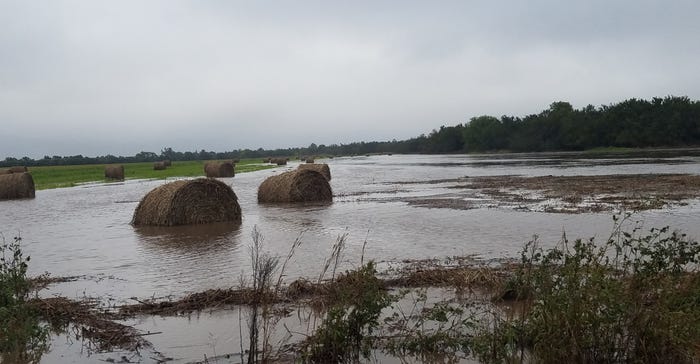
WET HAY: Flooding on the Medicine River in Barber County left this field of big round bales half-submerged.
After a summer of severe drought in parts of central and eastern Kansas, the rains came with a vengeance.
Between Oct. 6-9, most of Kansas received some rain and widespread downpours. Areas from Medicine Lodge in the southwest, to Chanute in the southeast, to Topeka and Emporia in the northeast received anywhere from 4.5 inches to 11 inches. The heavy rain flooded rivers and streams, inundating fields of soybeans, sorghum and cotton waiting for harvest and leaving fields of newly planted wheat standing in water.
The drenching rains were the remains of a little-noticed Pacific hurricane that made landfall in southern California and moved inland across the Four Corners region and into Oklahoma and Kansas. A similar system brought more rain over the weekend of Oct.13-14 and ushered in a cold front that brought the season’s first hard freeze, a snowstorm to western Kansas and flurries as far east as Wichita. First freeze in southern Kansas is "normally" around Oct. 21, making this year’s freeze officially a week early.
For Barber County farmer Tom Bedwell, the aftermath of the deluge that sent the Medicine River over its banks and across thousands of acres of farmland after between 8 and 11 inches of rain was mixed.
He had "dusted in" wheat the week prior to the big rains and was waiting for a few days of sunshine and warmer weather to see if it came up or had been washed out of the ground. Other fields, planted earlier, were up and growing, and Bedwell says he’s in "wait and see" mode to determine if they were under water long enough to do serious damage.
"For a lot of fields that weren’t affected by the river flooding, the rain came slow enough that a lot of it was absorbed," he says. "We got an inch of two at a time and that really helped. If it had come all in one day, it would have really been disastrous."
For those who were affected by river flooding, it was disastrous.
Near Mount Hope, members of the McCurry Brothers Angus family spent Oct. 12 driving bulls from flooded pastures to higher ground.
Farmer Jon McClure in Stafford County turned to work in his shop, getting ready for the day when the water receded and he could get back in the field to finish fall harvest and replant wheat – if indeed the day for replanting came soon enough to meet the deadline for insuring the crop.
In spite of having 70 acres of crops under water, McClure said that he refused to say a negative word about rain – even too much rain because all moisture is prized in his water-short region. What he did wish for, he said, was that it would have waited a couple of months until the fall harvest was in, the wheat was planted and the season advanced enough that a late onslaught of weeds wouldn’t be a problem.
In Lyons County, Kansas Wheat Commissioner Doug Keesling worried that wheat acres will be down markedly for 2019 because the delayed harvest will mean farmers don’t have time to get wheat in the ground. Flooded soybean, milo and cotton fields will put harvest off for at least a couple of weeks — and that’s if sunshine and warm weather linger after the October freeze.
"I wish we could harvest them like cranberries," Keesling says of his soybean "bog." Unfortunately, he says, fully ripened soybeans are not a crop that holds up well underwater.
In Reno County, Cow Creek near Hutchinson hit major flood stage on Oct. 9 and stayed that way through Oct. 14. The Arkansas River also hit major flood stage at Haven, and the Ninnescah River at Belle Plaine covered Highway 81 with 1.5 feet of fast-flowing water.
Minor to moderate flooding occurred on the Little Ark River. The Missouri, the Walnut, the Solomon, the Republican and the Saline rivers all left their banks.
Downtown Wichita was spared severe flooding even as the Arkansas River rose above the sidewalks and into the park grounds around the Century II Convention Center and the Hyatt Regency Hotel because of the ability to divert water into the Wichita-Valley Center Floodway, better known to locals as the "Big Ditch." The floodway was flowing strongly from the divergence point on the river in northwest Wichita all the way to Mulvane where it rejoins the Ark River — and where flooding was occurring downstream all the way to the Oklahoma border.
In Winfield, where the Walnut River and lesser streams left cotton standing in water, Southern Kansas Cotton Growers crop consultant Rex Friesen says the crop would probably weather the storm.
"Cotton is pretty resilient," he says. "There may be some staining on the lint that will cause a bit of quality loss and in areas where there was pounding rain, some of the bolls were knocked off and lost on the ground. But for the most part, it will dry out and there will still be a good harvest."
That’s good news for fall harvest where cotton is a bright spot. Before the flooding, the crop was rated more than 70% good to excellent, and yields are expected to be in the range of 2 to 3 bales per acre on dryland acres. Harvest was just beginning when the rains came.
About the Author(s)
You May Also Like




